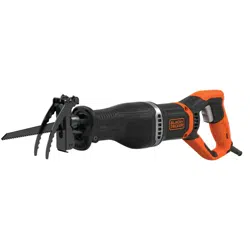Loading ...
Loading ...
Loading ...

5
ENGLISH
WARNING: Cut hazard. Blade breakage may occur
if the blade does not extend past the shoe and the
thickness of the workpiece during the cut. Increased risk
of personal injury, as well as damage to the shoe and
workpiece may result.
Blade Installation and Removal (Fig. B)
Different blade lengths are available. Use the appropriate
blade for the application. The blade should be longer than
3-1/2” (89 mm) and should extend past the shoe and the
thickness of the workpiece during the cut. Do not use jigsaw
blades with thistool.
To Install a Blade
1. Hold the tool away from thebody.
2. Rotate the blade clamp collar
3
.
3. Insert the shank of the blade
4
fully into the blade clamp
collar
3
.
4. Release the blade clamp collar
3
to lock the blade
intoposition.
NOTE: Blade can be installed with the teeth facing up to
assist in FlushCutting.
5. Release blade clamp collar and gently tug on the blade to
ensure blade is clampedsecurely.
To Remove a Blade (Fig. B)
WARNING: Burn hazard. Do not touch the the blade
immediately after use. Contact with the blade may
result in personalinjury.
ASSEMBLY AND ADJUSTMENTS
WARNING: To reduce the risk of serious personal
injury, turn unit off and disconnect it from
power source before making any adjustments or
removing/installing attachments or accessories.
An accidental start‑up can causeinjury.
Motor
Be sure your power supply agrees with the nameplate
marking. Voltage decrease of more than 10% will cause loss
of power and overheating. These tools are factory tested; if
this tool does not operate, check powersupply.
The label on your tool may include the following symbols. The
symbols and their definitions are asfollows:
BPM .................... beats per minute
V ......................... volts
min ..................... minutes
j
or DC ............direct current
…/min ..............per minute
RPM .................... revolutions per
minute
A ......................... amperes
Hz .......................hertz
W ........................watts
Wh ......................watt hours
n
o
.......................no load speed
n .........................rated speed
c
.....................safety alert symbol
h
..................... wear respiratory
protection
f
..................... wear eye protection
i
..................... Class II Construction
(double insulated)
g
..................... wear hearing
protection
a
..................... read all
documentation
n
..................... avoid staring at
light
l
or AC............alternating current
Ah ....................... amp hours
WARNING:
Some dust created by power sanding,
sawing, grinding, drilling, and other construction activities
contains chemicals known to the State of California to
cause cancer, birth defects or other reproductive harm.
Some examples of these chemicalsare:
• lead from lead‑based paints,
• crystalline silica from bricks and cement and other
masonry products, and
• arsenic and chromium from
chemically‑treatedlumber.
Your risk from these exposures varies, depending on
how often you do this type of work. To reduce your
exposure to these chemicals: work in a well ventilated
area, and work with approved safety equipment, such
as those dust masks that are specially designed to filter
out microscopicparticles.
• Wear protective clothing and wash exposed areas
with soap and water. Allowing dust to get into your
mouth, eyes, or lay on the skin may promote absorption of
harmfulchemicals. Direct particles away from face andbody.
• Use the appropriate dust extractor vacuum to remove
the vast majority of static and airborne dust. Failure
to remove static and airborne dust could contaminate the
working environment or pose an increased health risk to
the operator and those in closeproximity.
• Use clamps or other practical ways to secure and
support the workpiece to a stable platform. Holding
the work by hand or against your body is unstable and may
lead to loss ofcontrol andinjury.
• Air vents often cover moving parts and should be
avoided. Loose clothes, jewelry or long hair can be caught
in movingparts.
• An extension cord must have adequate wire size
(AWG or American Wire Gauge) for safety. The smaller
the gauge number of the wire, the greater the capacity
of the cable, that is, 16 gauge has more capacity than 18
gauge. An undersized cord will cause a drop in line voltage
resulting in loss of power and overheating. When using
more than one extension to make up the total length,
be sure each individual extension contains at least the
minimum wire size. The following table shows the correct
size to use depending on cord length and nameplate
ampere rating. If in doubt, use the next heavier gauge. The
lower the gauge number, the heavier thecord.
Minimum Gauge for Cord Sets
Volts
Total Length of Cord in Feet
(meters)
120 V 25 (7.6) 50 (15.2) 100 (30.5) 150 (45.7)
240 V 50 (15.2) 100 (30.5) 200 (61.0) 300 (91.4)
Ampere Rating
American Wire Gauge
More
Than
Not
More
Than
0 6 18 16 16 14
6 10 18 16 14 12
10 12 16 16 14 12
12 16 14 12 Not Recommended
Loading ...
Loading ...
Loading ...
